
JAGUAR XJR
Generations Timeline, Specs and Pictures
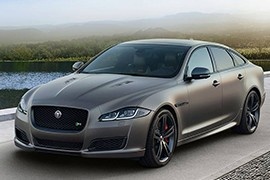
The Jaguar XJ575 was not the smoothest car to be chauffeured in, but it was way more subtle than an S-Class AMG or an Audi S8.
Jaguar introduced the 575 version for the XJ in 2017 as a 2018 model year, and it was more than just the regular limo that could take the owner from A to B. Depending on the customers” options, the car could have been looked subtle or not, but regardless of that, it was fast. Very fast, actually!
Unlike the rest of the XJ range, the XJR575 featured a different bumper with a lower apron and a big, black-mesh grille. The Jaguar badge was red as a reminder that it was not just a regular version. Regardless of thecar’ss color, the vents on the hood betrayed thecar’ss supercharged engine under the hood. For the headlights, the British carmaker its J-signature LED daytime running lights.
Inside, the car featured a different interior than the rest of the XJ range. It was still luxurious, but the high-bolstered front bucket seats sported a diamond-quilted leather upholstery. There were plenty of 575 red badges in the car to remind the occupants what the car was. A 1” touch-screen monitor was placed on the center stack and controlled various car functions, including the climate controls, the navigation, or the sound system. In the long-wheelbase version, the XJ575 offered more than one meter (3 ft) of legroom.
The five-liter supercharged engine produced 575 hp, and Jaguar paired it with an eight-speed automatic gearbox. It sent all the power to the rear wheels. Thanks to that setup, the car could rocket from zero to 60 mph (0-97 kph) in 4.2 seconds. Unlike most German fast premium sedans, it could go up to 186 mph (299 kph).
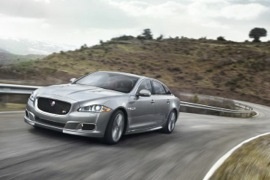
The R model is the flagship of the XJ range from Jaguar, incorporating new chassis and aerodynamic developments that makes it the most focused, agile and responsive member of the range.
It offers greater steering precision, higher level of control, high-speed stability as well as greater power and torque from it’s 5.0-liter supercharged V8. The suspension has been tuned and tested on race tracks like the Nurburgring and the Rockingham circuit in England. To achieve maximum benefit from it, the car is fitted with lightweight 30-inch Farallon alloy wheels and Pirelli tires measuring 265/35 front and 295/30 rear. Also, the high performance saloon has Adaptive Dynamics system to control vertical body movement, roll and pitch, and a high tuned active electronic differential. The designers wanted the car to flash it’s sportiness on the outside too, so it has chrome-rimmed intakes, front aero splitters, R spec side sills a bootlid-mounted spoiler and other subtle design modifications that reflect the changes from under the hood.

Jaguar introduced the supercharged version of its flagship model XJ in 1994, and the customers were delighted.
So, the British carmaker continued to offer it to the following generations.
In 2003, Jaguar introduced the third generation of its XJ series and, the sportiest version featured the magnificent V8 supercharged engine. But it wasn’t just the power under the hood that made the car great. It was the whole package with aluminum bodywork, aluminum arms and struts, and the air-suspension.
For starters, the XJR sported a different grille than the rest of the range. Its silver mesh-grille mimicked the look of the older glorious Jaguar racing cars. The new headlights featured lens-projectors that made the vehicle looks modern. Unlike the rest of the pack, the XJR front bumper was lowered and aerodynamically profiled to channel the air to the front disc brakes. For the European market, Jaguar had to remove the hood’s statue due to new pedestrian protection regulations.
Inside, the carmaker introduced updated materials and combined the wood and aluminum trims, offering a sporty yet elegant look. On the center console, the J-pattern gear selector was kept. Since it was under Ford ownership, it couldn’t get rid of the Ford Fiesta buttons that altered the exclusive car’s look.
Under the hood, there was the same supercharged 4.2-liter V8 from the non-facelifted version. It provided 100 hp more than the naturally aspirated unit. Jaguar paired that engine exclusively with a 6-speed automatic gearbox.
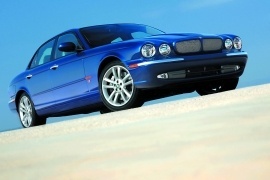
After a few difficult years, Jaguar finally ended-up in Ford portfolio along with Aston-Martin, Volvo, and Land Rover.
But the struggles just began.
When the XJR V8 was introduced in 1997, the British engineers placed their bets on the newly developed 4.0-liter supercharged unit. After Ford purchased the company in 1999, the luxury company went through different transformations, which dictate them to replace the older XJ generation with a new model in 2003.
From the outside, the visual identity remained strong. The four-round headlights were kept in place. At a glance, some could say that it was just a facelift, but it was more than that. The cabin was slightly higher to allow taller people to fit inside. The wheelbase was longer, and the aluminum panels were extensively used to make the car lighter.
Inside, Ford started to put its Fiesta and Mondeo buttons everywhere. They didn’t have the same premium look as before. It kept the same J-pattern for the automatic gearbox selector, and the luxurious feeling was there to impress its occupants. Moreover, the XJR was able to impress its driver as well.
Under the hood, there was a new, 4.2-liter V8, which was based on the previous 4.0-liter unit from the 1997 Jaguar lineup. The increased displacement, along with other tweaks in the car’s electronics, provided almost 40 hp more than on its predecessor. The old, 5-speed automatic gearbox was dropped in favor of a new, 6-speed unit. And the driver was impressed.
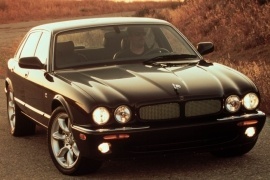
While nobody complained about the XJ sedan of being slow or underpowered, the British Company suddenly remembered that they were once glorious on the race tracks.
And they brought the XJR.
In 1997, Jaguar decided that it had enough inline-six engines for its high-class vehicles, so it decided to introduce a new engine generation, the AJ-V8 units. As the name suggested, they were V8, and the company engineers thought there was room for improvement, so they added a supercharger on it!
From the outside, there were just a few clues that could tell someone that that was an XJR. Sure, there was a silver mesh-grille instead of the body-colored one. There was a specific set of light-alloy wheels on the fast, four-door British car. Also, there was a dual exhaust with each pipe on one side of the vehicle in the back. Moreover, the new generation of the XJ, introduced at the 1997 Frankfurt Motor Show, was sleeker and made many tall people crying due to its low-roof greenhouse. But the others didn’t care.
Inside, it was the same British luxury atmosphere as it was before garnished with leather, wood, and fine materials. The buttons were installed where they were supposed to be and not hidden behind the steering wheel. The J-shaped gear-selector was typical for Jaguar only. The room in the back was adequate for average-sized passengers. The tall ones, on the other hand, were not happy at all.
Under the hood, the XJR featured a newly developed 4.0-liter V8 supercharged engine that produced more power than the XJS V12 sports car. The gearbox was the 5G-Tronic carried-over from Mercedes-Benz. The result was a surprisingly fast luxury sedan.
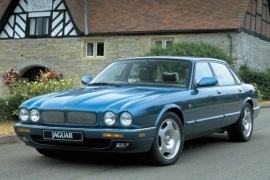
There was something about Jaguar that no one could take: its sleek look and exquisite feeling of a British car, made for the driver and the passengers as well.
And there was the XJR.
Most of the British cars were involved in racing, at least most of those who stand on four wheels, not those wheelbarrows with a roof that tipped over easier than a toddler on the first day walking. When Jaguar was a race-winner and built luxury vehicles, other premium carmakers didn’t even exist.
Designed as a luxury vehicle, and launched in 1994 at the Paris Motor Show, the second generation of the XJ – X300 was appreciated for its lines. Unlike other sedans on the market, it showed a low overall height and a sloped trunk lid. At the front, the four, round headlights and the chromed grille looked sportier than other sports cars on the market, but with a twist of elegance. Unlike its non-R versions, the XJR featured a mesh-grille instead of the classic one with vertical slats.
Inside, there was less headroom than in a Fiat Panda. The low seats made the occupants feel like they were in a sports car. That was in a contradiction between the wood-trims on the dash, the leather seats, and the manual gearbox. The XJR featured a few clues to tell the driver that it was more than a luxurious vehicle.
Jaguar installed an inline-six engine under the hood. It was the same 4.0-liter unit from other versions but, this time, aided by a supercharger. As a result, the luxurious vehicle was able to keep pace with other sports vehicles from those times and still be able to make a good impression when it appeared in front of Buckingham Palace.

The XJR-15 was a Jaguar like no other road-car ever made by Jaguar.
It was closer to the LeMans winning XJR-9 model, which took the crown at the famous endurance race in 1990 and in 1992.
The car was not designed by Jaguar. It was the creation of Peter Stevens, the man who designed the McLaren F1 later in his career. The XJR-15 featured a mid-engine architecture and no soundproofing at all. That helped the car achieve a very low overall weight of under 1100 kg (2336 lbs). The car was created by Tom Walkinshaw Racing. They said that they started with the racing vehicle, made the cabin wider and taller to accommodate two adult-sized passengers. Only 53 units were made.
The flatform with a bulb-like greenhouse on top was typical for a race-car from its era. There were two versions made: one for the road and one for racing. The road-going version, which was able to be registered, featured the turn signals and wider rear-view mirrors.
Inside, the cockpit featured two race-bucket seats and a dashboard filled with race-type switches and more gauges for speed, temperature, oil pressure, tachometer, etc. It didn’t feature any radio, but it did have an intercom system with two headphones for the occupants.
The engine was a 6.0-liter Jaguar V12 unit, jointly manufactured by JaguarSport, a company jointly created by TWR and Jaguar. The British brand was never actually involved in the production. At least, not officially.























































